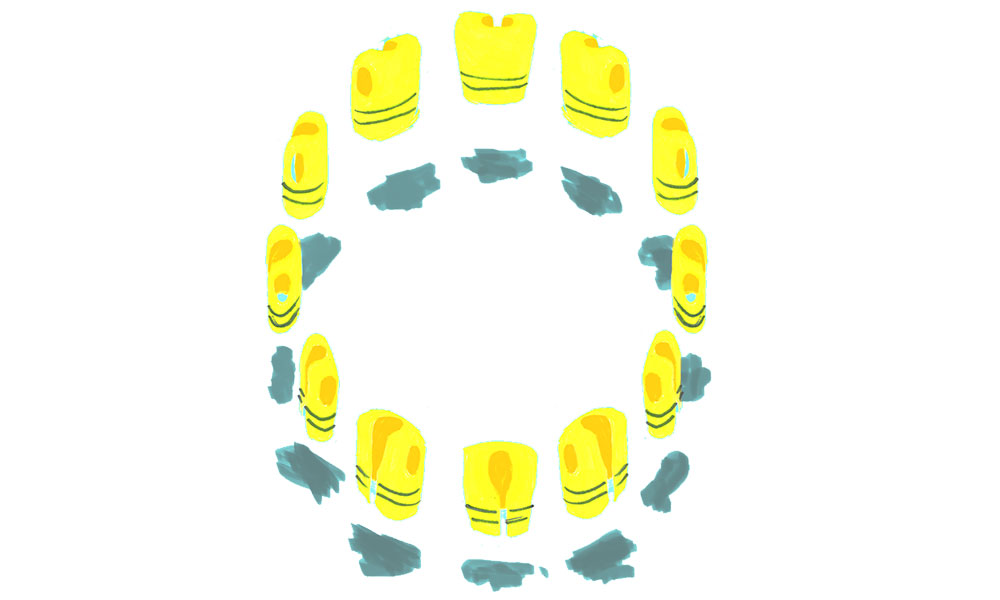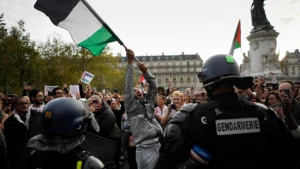
From the moment the Yellow Vests appeared, the movement and its participants evaded characterization. Who are the Yellow Vests? What do they want? How should the Left intervene in the movement? How far will it go? As the protests gained momentum in late 2018 and early 2019, the Yellow Vests’ demands broadened. Initially protesting a fuel tax hike, they were soon calling for the resignation of President Emmanuel Macron, radical democratic reforms, and substantial improvements to people’s standard of living. At its peak, the Yellow Vest movement instilled a deep fear in the ruling class. And as shown by the popular uprisings erupting around the globe—in Ecuador, Lebanon, Haiti, Puerto Rico, and Chile, among others—they have good reason to fear.
Since the crisis of 2008–9, the global political situation has been marked by increasing geopolitical tensions and inter-imperial rivalries, the rise of right-wing populism, and offensives against the working class. The Yellow Vest movement emerged as these tensions reached a breaking point. Sectors of the population that felt the effects of these developments but had not participated in politics before suddenly burst onto the scene. The protests clashed directly and violently with the government on a large scale, which was a shock in a country notorious for the way it maintains law and order.
It is no wonder, then, that echoes of the Yellow Vest demonstrations can be heard in the chants and slogans of new struggles across the world. Other anti-government movements have taken up the reflective vests as a symbol. In Hong Kong, for example, many Yellow Vests were visible among the hundreds of thousands of people protesting in the streets against the Chinese government. Yellow Vests also appeared among protesters participating in the massive demonstrations in Algeria that brought about the resignation of President Abdelaziz Bouteflika, creating an image even more significant given France’s official colonial rule of that country until 1962.
Though the movement is not without considerable contradictions and limitations, the emergence of the Yellow Vests is an expression, through class struggle, of a global trend toward organic crisis; that this mass spontaneous movement emerged in an imperialist power reveals that the crisis is reaching a fever pitch. Consequently, the movement has crucial strategic lessons to teach socialists, especially in the United States, about the role that class struggle plays in pushing forward the consciousness of the working class and sectors of the petty bourgeoisie; the reactionary role of the union bureaucracy; and the necessity of a revolutionary party to give shape to the spontaneity of mass movements and to articulate a challenge to the bourgeoisie.
France’s Organic Crisis
The last three years in France have been marked by a high degree of class struggle. The most recent large-scale mobilizations occurred in 2016 in response to the labor reforms passed by President François Hollande, from the center-left Socialist Party. The law, which allowed employers to increase working hours and made it easier to fire workers, provoked three months of intense class struggle, which was met with equally intense police repression. The student movement played a key role in these mobilizations, as did the strikes of workers in all eight of France’s oil refineries. The struggles against the labor reforms also saw the emergence of the Nuit Debout (Up All Night) phenomenon, a youth-led movement that held nightly assemblies and occupations at the Place de la République in Paris and in other places. Despite the massive protests, Hollande pushed the anti-labor bill through. The union bureaucracy was key to this defeat, putting the brakes on the mass mobilizations in favor of negotiations with Hollande’s government. Its actions sowed widespread disillusionment in the labor movement for years to come.
The neoliberal policies pushed by the Socialist Party caused a rupture in France’s political landscape. Discontent with Hollande and the weakness of the Left opened space for the rise of right populism, embodied in the candidacy of Marine Le Pen of the National Front (now called the Rassemblement National). In turn, technocratic neoliberalism renewed itself with the rise of Emmanuel Macron.
In response to this crisis of the political regime, Macron emerged from the center of the Socialist Party, portraying himself as an anti-establishment politician. Giving himself the name of “Jupiter,” Macron positioned himself as the bourgeoisie’s answer to France’s malaise, one who could implement ambitious neoliberal policies to open France’s markets and strengthen the European Union. He promised to hold the center in opposition to Le Pen’s Far Right politics, inspiring hope among France’s ruling class. After a surprise victory brought him to power, Macron delivered on these promises, weakening the workers’ movement with anti-union legislation.
One of Macron’s first acts as president was to cut benefits for employees of France’s national railway company, SNCF, and revoke the company’s public status. Workers in this sector went on strike against the measures, which would facilitate the privatization of the railway company, but the months of protest were not enough to prevent the Senate from overwhelmingly approving Macron’s reform. These measures—combined with other legislation that significantly limited the influence of trade unions, laid off civil service workers, and cut funding to social programs—did nothing to bolster Macron’s popularity or resolve the growing tensions between the bourgeoisie and the rest of French society.
That Macron ran his campaign outside the traditional parties was at once a strength and a weakness. Though he appeared to usher in a new era of French politics, his break with the establishment meant that from the start, he lacked a broad social base. Instead, he continued to rely on big business, taking on the role of “president of the elite.” Consequently, his reforms further alienated him from the masses. Only a month into his presidency, his approval ratings fell below 50 percent. Upholding bourgeois interests with an authoritarian rhetoric, Macron ushered in the appearance of the Yellow Vests in late 2018.
The Straw That Broke the Camel’s Back
In July 2018, under the guise of environmental “sustainability,” the government announced a rise in fuel taxes, which especially affected workers as well as small business owners in the suburbs outside France’s major cities. The reaction against the fuel tax was immediate and explosive. A call went out on social media for people to go into the street on November 17. This spontaneous movement mobilized three hundred thousand people across the country—in cities and in the suburbs, converging around roundabouts and constructing barricades to obstruct traffic. It drew entirely new sectors of the population into class struggle, many of whom had never participated in politics before.
These individuals came from sectors of the middle class that had been disenfranchised not just by the two years of Macron’s rule but by decades of neoliberal governments from both the Right and Left. They had been increasingly pushed to the margins of French society, feeling abandoned by a government that cut public services like hospitals, public transport, and education. With little faith in either traditional political parties or traditional workers’ organizations, these individuals organized themselves without a defined leadership or a class perspective.
As the “Acts” continued each Saturday, the movement intensified and radicalized. In just two weeks, protesters went from demanding an end to the fuel tax hike to demanding Macron’s resignation and a radical improvement in the standard of living for the majority of people. Other sectors of the population joined the protests, including the student movement and various political organizations on the Left and Right. The peak of the movement came on December 8, when Yellow Vests occupied the area around the Arc de Triomphe, directly challenging the government. As the protests and clashes with the police escalated, Macron was forced to escape the Élysée Palace in a helicopter while the military was deployed to aid the police.
When Concessions Meet Repression
After only three weeks of demonstrations, the French government was forced to announce that it would delay the fuel tax hike for six months. One day later, it canceled the plan altogether. Rather than stopping at this first major success, the Yellow Vests pushed further, and only two weeks later, Macron announced a series of measures to aid workers: a 100 euro monthly raise in the minimum wage and the repeal of taxes on overtime and bonus pay.
But as the Yellow Vests continued to call for Macron’s resignation, making it clear that they were not going away, the government shifted its approach to one of uncompromising repression. The Yellow Vest mobilizations brought new sectors into direct confrontation with the full repressive force of the state. Police violence in Paris surpassed that seen at the height of the Black Lives Matter movement in Ferguson in 2014. Even the UN accused the French authorities of “excessive use of force.” At least eleven people have been killed since the demonstrations began. Over two thousand protesters have been injured; some have lost hands from flash grenades, while others have lost eyes to rubber bullets. Thousands more have been arrested and harassed by police.
Macron supplemented the state violence with legislative measures that limit the right to demonstrate and that criminalize self-defense against police. In March, the police banned all protests on the Champs-Élysées and raised fines for illegal assemblies. In April, Macron signed an “anti-rioter” bill that made it illegal for demonstrators to wear face masks, whether they were worn to protect protesters’ identities or to protect against tear gas. Though Macron had been forced to retreat early on, he increasingly relied on military forces to preserve order. As a result of the movement’s strategic inability to combat these repressive measures, participation in the protests began to dwindle. Public support remained relatively high, however, outstripping Macron’s approval ratings even as late as October 2019.
The Criminal Role of the Union Bureaucracy
The Yellow Vests included broad sectors of the working class, including those organized in trade unions. France’s unions, however, maintained an uneasy relationship with the movement from the beginning, and this prevented labor from decisively intervening in the struggle.
Many Yellow Vests had little faith in the unions and their leaders, who for years had failed to combat neoliberal offensives or had openly supported them. During the strikes of 2016 and 2018, the CGT, France’s most combative union, chose a losing tactic of intermittent actions, that divided strike efforts and could not effectively disrupt key sectors of the economy. They opposed general strikes in favor of these more isolated actions, in order to reduce the risk of the bosses’ retaliation and to remain welcome at the bargaining table. This allowed both successive rounds of reforms to pass. As a result of this betrayal and others, both the rank-and-file workers and the wider population lost trust in the labor movement’s ability to beat austerity.
The majority of the participants in the Yellow Vest protests consequently came from outside France’s key industries. Most of them were not organized in trade unions, and based on the experience of the last ten years, many felt ignored and abandoned by the unions. For this reason, the Yellow Vests and labor movement have largely remained separate, even when their interests are directly aligned. While union leaders remained passive, the Yellow Vests fought for demands such as a raise in the minimum wage and in pensions.
For their part, the unions (even ones with leftist sympathies, like the CGT) distanced themselves from the Yellow Vests, instead aligning with the government. Throughout almost a year of protests, many unions issued statements that painted the movement as reactionary and rooted in Far Right ideology. The most glaring example of this came in December 2018, when the CGT denounced the violence of the weekly demonstrations without any acknowledgment of the violent repression being meted out against demonstrators week after week.
Although politically conscious members of the unions fought within their organizations to link the labor movement to the Yellow Vests, the union leaders refused to substantially intervene. They called mini-strikes and held marches on separate days from those of the Yellow Vest demonstrations. The exception was the general strike of February 6, when union leaders were forced to ally with the Yellow Vests for a day of demonstrations and marches. It brought hundreds of thousands of people into the streets across France, but because it lacked a larger strategic shift toward unity, its significance remained symbolic. By May Day of 2019, the unions were once again separating their own demonstrations from the militant protests of the Yellow Vests.
The Yellow Vests have been largely unable to connect with the labor movement, not because they refused to take up workers’ demands, but because the union leaders refuse to challenge the government’s reforms. The union bureaucracies preferred to negotiate with the government behind the backs of their own rank and file and the Yellow Vests. In this way, the union bureaucracy acts as another arm of the state, reigning in the anger of the workers and redirecting it toward reforms that are entirely compatible with the interests of capital.
In the United States, where the labor movement is weaker and more degenerate than in France, the role of the unions in the Yellow Vest movement should be taken as a portent of things to come. Though organized and unorganized workers in the United States are increasingly waking up to the bankruptcy of their union leaders, as can be seen in the wildcat teacher strikes of 2018, without credible challenges from the rank and file, union leaders are still in control. The points at which the labor movement was able to converge with the Yellow Vests came about due to left pressure from within the unions. Socialists must organize in unions before moments of crisis. For any movement, building organic ties to workers’ organizations will require a struggle against union leaders who, in moments of acute struggle, demobilize, restrict demands, and avoid class conflict in favor of institutional negotiations.
The Left Was Unprepared
Despite the Yellow Vests’ progressive demands, the organizations of the extreme Left could not gain a real foothold in the movement. It remained an expression of left populism, in which the demands of the middle class and petty bourgeois sectors dominated over those of the working class. As in the United States, the movement was met with substantial skepticism from France’s Left: It was accused of being anti-environmentalist, co-opted by the Far Right, or apolitical, and therefore not a movement that could lead to a revolutionary situation. Though left organizations participated in the demonstrations (far outnumbering participants from the Far Right), there was no revolutionary socialist force with enough influence to push for the development of bodies of self-organization or to broaden the movement to other social sectors. In other words, there was no revolutionary party with sufficient material forces and roots in the workers’ movement to help guide the activists to anti-capitalist conclusions.
Without this left pressure, the protests were forced to either funnel participants’ energies into supporting one of the established reformist or explicitly bourgeois parties, or to remain outside of the electoral sphere completely. As the results of the European elections in May showed, the movement tended toward the latter and began to dwindle over the summer.
A Strategic Impasse Limits the Movement
Though the Yellow Vests threatened France’s ruling class, the movement fell into a “strategic impasse.” Six months of radical demonstrations forced Macron to make concessions on several occasions, but they could not oust him. The Yellow Vests needed a new strategy, one capable of uniting the masses at a strategic point to create a united, all-out offensive against the government. They needed to include other sectors of the population, particularly among the urban poor, the youth, and the working class, while developing beyond their self-identification as a movement of the classless “people.” As the eventual decline of the protests showed, spontaneity alone was not enough.
Part of the problem was the low level of self-organization within the movement. As a reaction to Macron’s government placing itself above the majority of French society, the Yellow Vest movement from its beginning focused on an expansion of “democracy.” This expressed itself to some degree in the assemblies held throughout the country, during which Yellow Vests gathered to discuss and organize their demonstrations. At their height, assemblies such as that in Saint-Nazaire brought together two hundred delegates from across the country. These demonstrated the potential to form an alternative pole in opposition to the self-proclaimed leaders of the movement.
The assemblies were, however, never widespread or organized enough to draw new sectors into the movement and develop a strategy capable of beating capital. This is a result of the structural contradiction of the movement and its overreliance on horizontal democracy. As Isabelle Garot explains in Communism and Strategy,
In some ways, the craze for direct democracy conveys the illusion of a potentially reunited people, able to resolve social issues by majority and referendum, bypassing the fundamental class struggle of capitalism. Yet, at the same time, it testifies to the search for contemporary forms of self-government that give the right to collective decision and debate, taking at face value the principle of popular sovereignty.1Isabelle Garo, Communisme et strátegie (Paris: Éditions Amsterdam, 2019), 239. Our translation.
In other words, the assembly structures had the potential to develop into centers of power for the movement, but without a clear class character, that energy quickly dissipated. This showed the relative lack of influence of the Left in the movement and especially in the assemblies themselves. Within such structures, it is the task of revolutionaries to advocate for broad democracy while arguing for an independent revolutionary program and strategy.
Class Struggle Produces Class Consciousness
Globally, the Yellow Vest movement was one of the first expressions of a new challenge to neoliberal domination. At the height of the movement, France tended toward a prerevolutionary situation. The movement caught the bourgeoisie unawares and reminded it that its hegemony is far from certain.
But the movement also raises important strategic challenges for socialists who hope to see this latest cycle of class struggle become a force that can confront the entire system of capitalist exploitation. It was a mass movement that emerged spontaneously from below, independent of bourgeois political parties, and it created a whiff of revolution, despite the repression. The protests disrupted business as usual for one of the world’s strongest imperialist powers for over six months.
The Yellow Vests movement began with a single demand, but within just a few months, protesters were calling for radical transformations of society. These demands developed rapidly as a result of the demonstrators’ experience.
Furthermore, the movement showed a broad swath of people that the police are always on the side of the capitalists and that the state will respond with the harshest measures when threatened. This has been reflected in the movement’s demands, which include transformations of the judicial system and the abolition of the police.
To put it simply, class consciousness does not appear fully formed but develops rapidly in the course of the struggle. It is in acute processes of class struggle that the majority of the population begins to understand the relationship between the state and the people, realizing their interests will never be served by the agents of the bourgeoisie.
This consciousness will, however, dissipate or dissolve into electoral politics if it does not link up with a program of the working class and its allies, a program that calls for an uncompromising, revolutionary fight for socialism. It is the task of socialists to intervene in these movements to ensure that they do not lose steam. For this, a revolutionary socialist party is necessary, one with deep roots among workers, youth, and all oppressed groups, and one that can rally these sectors behind a strategy for the working class to seize power and expropriate the bourgeoisie. A party of this type cannot survive without the radicalization of the masses, but neither can its leadership and program arise spontaneously. It must prepare beforehand by honing its political perspective and intervening in class struggle, to fully seize upon moments when the masses burst onto the world stage as participants in history.
Notes
| ↑1 | Isabelle Garo, Communisme et strátegie (Paris: Éditions Amsterdam, 2019), 239. Our translation. |
|---|











